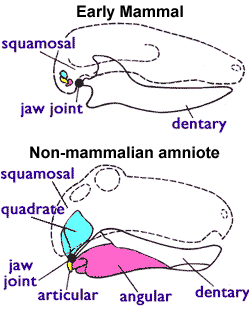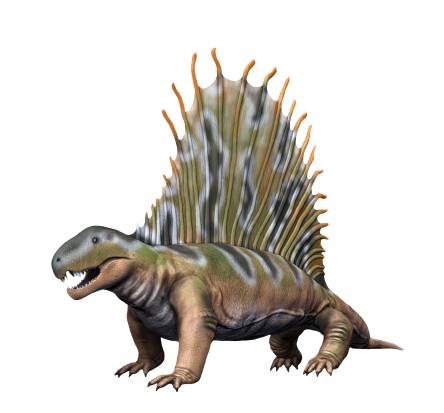|
Suprangular
The surangular or suprangular is a jaw bone found in most land vertebrates, except mammals. Usually in the back of the jaw, on the upper edge, it is connected to all other jaw bones: dentary, angular, splenial and articular. It is often a muscle attachment site. It has been noted in dinosaur Dinosaurs are a diverse group of reptiles of the clade Dinosauria. They first appeared during the Triassic Geological period, period, between 243 and 233.23 million years ago (mya), although the exact origin and timing of the #Evolutio ...s. References Skull bones {{Vertebrate anatomy-stub ... [...More Info...] [...Related Items...] OR: [Wikipedia] [Google] [Baidu] |
Angular Bone
The angular is a large bone in the lower jaw (mandible) of amphibians and reptiles (birds included), which is connected to all other lower jaw bones: the dentary (which is the entire lower jaw in mammals), the splenial, the suprangular, and the articular. It is homologous to the tympanic bone in mammals, due to the incorporation of several jaw bones into the mammalian middle ear early in mammal evolution. In therapsids (mammal ancestors and their kin), the lower jaw is made up of the dentary (the mandible in mammals) and a group of smaller "postdentary" bones near the jaw joint. As the dentary increased in size over millions of years, two of these postdentary bones, the articular and angular, became increasingly reduced and the dentary eventually made direct contact with the upper jaw. These postdentary bones, even before their articular function was lost, probably transmitted sound vibrations to the stapes and, in some therapsids, a bent plate that might have supported a memb ... [...More Info...] [...Related Items...] OR: [Wikipedia] [Google] [Baidu] |
Dentary
In jawed vertebrates, the mandible (from the Latin ''mandibula'', 'for chewing'), lower jaw, or jawbone is a bone that makes up the lowerand typically more mobilecomponent of the mouth (the upper jaw being known as the maxilla). The jawbone is the skull's only movable, posable bone, sharing joints with the cranium's temporal bones. The mandible hosts the lower teeth (their depth delineated by the alveolar process). Many muscles attach to the bone, which also hosts nerves (some connecting to the teeth) and blood vessels. Amongst other functions, the jawbone is essential for chewing food. Owing to the Neolithic advent of agriculture (), human jaws evolved to be smaller. Although it is the strongest bone of the facial skeleton, the mandible tends to deform in old age; it is also subject to fracturing. Surgery allows for the removal of jawbone fragments (or its entirety) as well as regenerative methods. Additionally, the bone is of great forensic significance. Structure ... [...More Info...] [...Related Items...] OR: [Wikipedia] [Google] [Baidu] |
Articular
The articular bone is part of the lower jaw of most vertebrates, including most jawed fish, amphibians, birds and various kinds of reptiles, as well as ancestral mammals. Anatomy In most vertebrates, the articular bone is connected to two other lower jaw bones, the suprangular and the angular. Developmentally, it originates from the embryonic mandibular cartilage. The most caudal portion of the mandibular cartilage ossifies to form the articular bone, while the remainder of the mandibular cartilage either remains cartilaginous or disappears. In snakes In snakes, the articular, surangular, and prearticular bones have fused to form the compound bone. The mandible is suspended from the quadrate bone and articulates at this compound bone. Function In amphibians and reptiles In most tetrapods, the articular bone forms the lower portion of the jaw joint. The upper jaw articulates at the quadrate bone. In mammals In mammals, the articular bone evolves to form the ... [...More Info...] [...Related Items...] OR: [Wikipedia] [Google] [Baidu] |
Proceratosaurus Bradleyi Skull Reconstruction (alt)
''Proceratosaurus'' ( ) is a genus of theropod dinosaur that lived during the Middle Jurassic in what is now England. The holotype and only known specimen consists of a mostly complete skull with an accompanying lower jaw and a bone, found near Minchinhampton, a town in Gloucestershire. It was originally described as a species of ''Megalosaurus'' in 1910, ''M. bradleyi'', but was moved to its own genus, ''Proceratosaurus'', in 1926. The genus was named for its supposed close relationship with ''Ceratosaurus,'' later shown to be erroneous, due to perceived resemblance of ''Proceratosaurus''' incomplete cranial crest to ''Ceratosaurus nasal horn. A small to medium-sized dinosaur, the skull of ''Proceratosaurus'' is long as preserved, and the dinosaur is estimated to have measured around in length. The skull is characterised by a number of distinguishing features, including a cranial crest that begins at the junction between the and the nasal bone. The teeth are heterodont, ha ... [...More Info...] [...Related Items...] OR: [Wikipedia] [Google] [Baidu] |
Dimetrodon Skull Lateral
''Dimetrodon'' ( or ; ) is an extinct genus of sphenacodontid synapsid that lived during the Cisuralian (Early Permian) epoch of the Permian period, around 295–272 million years ago. With most species measuring long and weighing , the most prominent feature of ''Dimetrodon'' is the large neural spine sail on its back formed by elongated spines extending from the vertebrae. It was an obligate quadruped (it could walk only on four legs) and had a tall, curved skull with large teeth of different sizes set along the jaws. Most fossils have been found in the Southwestern United States, the majority of these coming from a geological deposit called the Red Beds of Texas and Oklahoma. More recently, its fossils have also been found in Germany and over a dozen species have been named since the genus was first erected in 1878. ''Dimetrodon'' is often mistaken for a dinosaur or portrayed as a contemporary of dinosaurs in popular culture, but it became extinct by the middle Permi ... [...More Info...] [...Related Items...] OR: [Wikipedia] [Google] [Baidu] |
Jaw Bone
The jaws are a pair of opposable articulated structures at the entrance of the mouth, typically used for grasping and manipulating food. The term ''jaws'' is also broadly applied to the whole of the structures constituting the vault of the mouth and serving to open and close it and is part of the body plan of humans and most animals. Arthropods In arthropods, the jaws are chitinous and oppose laterally, and may consist of '' mandibles'' or ''chelicerae''. These jaws are often composed of numerous mouthparts. Their function is fundamentally for food acquisition, conveyance to the mouth, and/or initial processing (''mastication'' or ''chewing''). Many mouthparts and associate structures (such as pedipalps) are modified legs. Vertebrates In most vertebrates, the jaws are bony or cartilaginous and oppose vertically, comprising an ''upper jaw'' and a ''lower jaw''. The vertebrate jaw is derived from the most anterior two pharyngeal arches supporting the gills, and usually bear ... [...More Info...] [...Related Items...] OR: [Wikipedia] [Google] [Baidu] |
Vertebrate
Vertebrates () are animals with a vertebral column (backbone or spine), and a cranium, or skull. The vertebral column surrounds and protects the spinal cord, while the cranium protects the brain. The vertebrates make up the subphylum Vertebrata with some 65,000 species, by far the largest ranked grouping in the phylum Chordata. The vertebrates include mammals, birds, amphibians, and various classes of fish and reptiles. The fish include the jawless Agnatha, and the jawed Gnathostomata. The jawed fish include both the Chondrichthyes, cartilaginous fish and the Osteichthyes, bony fish. Bony fish include the Sarcopterygii, lobe-finned fish, which gave rise to the tetrapods, the animals with four limbs. Despite their success, vertebrates still only make up less than five percent of all described animal species. The first vertebrates appeared in the Cambrian explosion some 518 million years ago. Jawed vertebrates evolved in the Ordovician, followed by bony fishes in the Devonian. T ... [...More Info...] [...Related Items...] OR: [Wikipedia] [Google] [Baidu] |
Reuters
Reuters ( ) is a news agency owned by Thomson Reuters. It employs around 2,500 journalists and 600 photojournalists in about 200 locations worldwide writing in 16 languages. Reuters is one of the largest news agencies in the world. The agency was established in London in 1851 by Paul Reuter. The Thomson Corporation of Canada acquired the agency in a 2008 corporate merger, resulting in the formation of the Thomson Reuters Corporation. In December 2024, Reuters was ranked as the 27th most visited news site in the world, with over 105 million monthly readers. History 19th century Paul Julius Reuter worked at a book-publishing firm in Berlin and was involved in distributing radical pamphlets at the beginning of the Revolutions of 1848. These publications brought much attention to Reuter, who in 1850 developed a prototype news service in Aachen using homing pigeons and electric telegraphy from 1851 on, in order to transmit messages between Brussels and Aachen, in what today is Aa ... [...More Info...] [...Related Items...] OR: [Wikipedia] [Google] [Baidu] |
Splenial
The splenial is a small bone in the lower jaw of reptile Reptiles, as commonly defined, are a group of tetrapods with an ectothermic metabolism and Amniotic egg, amniotic development. Living traditional reptiles comprise four Order (biology), orders: Testudines, Crocodilia, Squamata, and Rhynchocepha ...s, amphibians and birds, usually located on the lingual side (closest to the tongue) between the angular bone, angular and surangular.Watson, D. M. S. (1912). LXVII.—On some reptilian lower jaws. Journal of Natural History, 10(60), 573-587. References Skull bones {{Vertebrate anatomy-stub ... [...More Info...] [...Related Items...] OR: [Wikipedia] [Google] [Baidu] |
Dinosaur
Dinosaurs are a diverse group of reptiles of the clade Dinosauria. They first appeared during the Triassic Geological period, period, between 243 and 233.23 million years ago (mya), although the exact origin and timing of the #Evolutionary history, evolution of dinosaurs is a subject of active research. They became the dominant terrestrial vertebrates after the Triassic–Jurassic extinction event 201.3 mya and their dominance continued throughout the Jurassic and Cretaceous periods. The fossil record shows that birds are feathered dinosaurs, Evolution of birds, having evolved from earlier Theropoda, theropods during the Late Jurassic epoch, and are the only dinosaur lineage known to have survived the Cretaceous–Paleogene extinction event approximately 66 mya. Dinosaurs can therefore be divided into avian dinosaurs—birds—and the extinct non-avian dinosaurs, which are all dinosaurs other than birds. Dinosaurs are varied from taxonomy (biology), taxonomic, ... [...More Info...] [...Related Items...] OR: [Wikipedia] [Google] [Baidu] |






